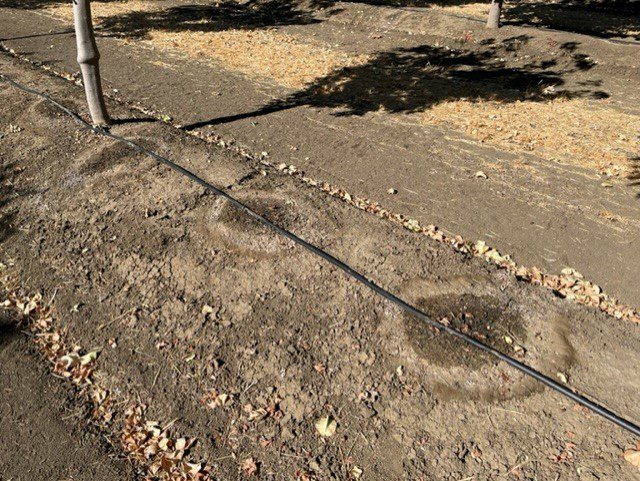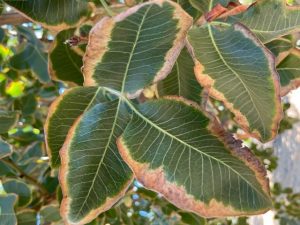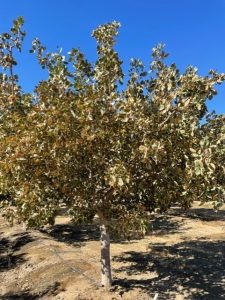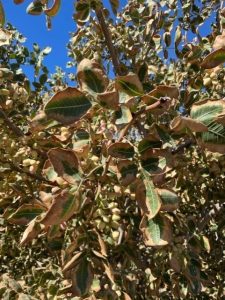
While farmers in California are short on water, they must also deal with too much salt in the soil. The problem is being worsened by poor-quality well water, especially in the westside of the San Joaquin Valley where saline soils and brackish water are more common. Although some salts are needed for crop production, at high-enough concentrations, they can reduce water uptake which may substantially reduce yield.
However, with diligence and time, a grower may be able to overcome high salinity issues in the field.

Soil and Water Analysis
The first step in combating high salinity is to understand how prevalent the issue is. A soil and water analysis needs to be done so that a grower knows how much salt is currently in their soil and how much is put on during irrigation. These tests will provide the grower with numerical values that can be more easily read and used to apply the proper management technique.
The pistachio production manual recommends taking samples in 1-foot increment depths to a minimum of a 4-foot depth taken from 6 to 12 locations per different soil type zone. Sampling locations should be evenly spread apart throughout the zone. Label each bucket for its corresponding depth (0’ to 1’, 1’ to 2’, etc.), and for each zone combine all samples from that depth. For each soil type zone, you will then have one composite sample for each depth increment.
Irrigation method should also be considered when choosing sampling locations. In flood-irrigated pistachios, sampling 5 to 10 ft to the side of the tree row is the best location. In sprinkler-irrigated pistachios, sampling should ensure that two-thirds of locations be within the wetting pattern of the sprinklers while one-third is taken outside the wetting pattern. The same method applies for microsprinklers and drip irrigation.
Sampling water quality is far less tedious than soil. First, rinse a plastic container (about 8 oz) in the water that you are sampling. Fill the container completely and seal the lid. If extracting water from a well, allow the water to run for 30 minutes before taking your sample. If possible, make sure to submit the water sample the same day you extract it. Usually, irrigation districts test for water quality and can supply you with this information.

Salinity Management Practices
Excessive salts (high salinity) in the root zone will not only reduce water uptake, but may also cause nutrient imbalance, affecting plant growth and yield. High concentration of specific ions can also become toxic to crops. Proper irrigation and agronomic management practices such as leaching and soil/water amendments can help reduce the adverse effects of salinity on crop production.
The key to salinity control and to irrigation sustainability is leaching. Leaching is the net downward movement of water and controls the salt distribution in the profile. When the crop root zone has become too saline, it requires extra water to leach out the accumulated salts by increasing the leaching fraction. Maintenance leaching is necessary to keep the average rootzone salinity below the plant threshold EC levels.
Reclamation leaching is the application of water until the soil salts are leached out of the intended root zone. Reclamation is needed when excessive salts will restrict production in an existing orchard or are found to be higher than acceptable tolerance levels in a soil being considered for development of a new orchard.
The main purposes for applying soil and/or water amendments are 1) to reduce sodium adsorption ratio (SAR) or exchangeable sodium percentage (ESP); and 2) to lower pH and release calcium in soils. The two general types of amendments are calcium salts and acid-forming amendments. The acid-forming amendments will reduce soil pH when applied in sufficient quantity and should not be used when the soil zone lacks significant amounts of lime.

Selection of a soil amendment for reclamation of a new orchard site or to sustain acceptable infiltration rates in an existing orchard is essentially dependent on the presence or absence of lime in the soil and the relative cost of the materials. If lime is abundant in the soil (particularly the surface soil), consider either a calcium salt or an acid-forming amendment. Another factor influencing the choice of an amendment is the product that will be added to the root zone. Some amendments add sulfates, others chloride or nitrate. Nitrate and chloride content will limit how much of these materials can be added. The amount of nitrogen should not exceed annual crop needs since it can be easily leached. Concentration of the Cl and impact on the pistachios should be insignificant when irrigation is sufficient. There have been no reports of sulfate accumulating to toxic levels in pistachios.
Final Considerations
During the late fall and winter, trees are not totally dormant but are much less metabolically active, therefore leaching practices are best to be done during dormancy/winter months. When performing these irrigation/salinity management practices, it cannot be stressed enough to be sure there is good infiltration of water going into the soil. The best way to apply excessive water with the goal to leach salts is to irrigate in multiple short intervals. The more you can spread out the timing of irrigations, the better. Make sure not to let any part of the rootzone dry out during this process as well. If the soil begins to dry during this process, there is a chance salts will instead get pulled closer to the soil surface. If nitrogen fertilization is needed, it should be applied to fields after deep leaching and not before.
The six steps of proper assessment of potential salinity problems include 1) Collect representative soil and water samples; 2) Understand terms used in an analytical report; 3) Check the quality of an analytical report; 4) diagnose different types of salinity problems; 5) Make remedial management decisions; and most importantly 6) Consult with a crop advisor before making any decisions.
A complete guide on how to manage salinity can be found online at cekern.ucanr.edu/files/98609.pdf.










